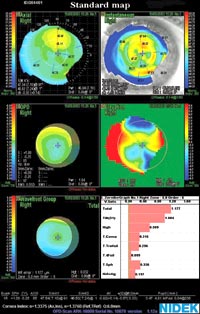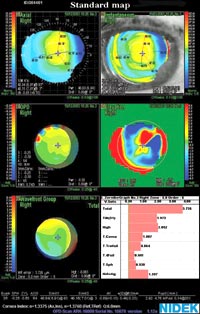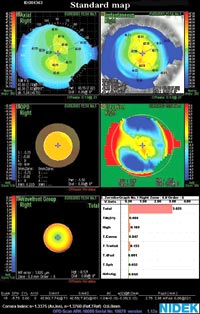Multifocal cornea an option for presbyopia, one surgeon says
The result is a progressive aspheric lens on the eye, giving vision at distance and near.
Click Here to Manage Email Alerts
A multizone corneal LASIK treatment, obtained using special software, can give presbyopic patients good near and distance vision with no loss of contrast sensitivity, according to a designer of the software.
The PAC software, which is not yet commercially available, was designed for the Nidek EC5000 excimer laser system by Alain Telandro, MD, in collaboration with Nidek engineers. It is now undergoing clinical trials at five centers internationally, said Dr. Telandro, of Cannes, France.
“This technique has been successfully performed in more than 500 patients, some of which have reached almost 2 years of follow-up. Results are extremely satisfactory and are constantly getting better along with the improvements of the Nidek program,” Dr. Telandro said.
He also added that the treatment has created a “snowball” effect in his practice. “The increasingly high number of patients who come for it is the best evidence that the treatment works,” he said.
Asphericity and multifocality
Dr. Telandro explained that multizone presbyopic LASIK is not a way of restoring accommodation, but a way of compensating for presbyopia through corneal asphericity and multifocality obtained with laser ablation.
“My work is based on the possibility offered by the Nidek laser of creating very wide optical zones. A first hyperopic treatment on a wide area is followed by a myopic treatment in the center. The aim, however, is not bifocality, but a very progressive aspheric lens, which is made possible by the smooth transition zones created by this laser,” he said.
 |  |
| Preop (top) and postop (bottom) maps, before and after Dr. Telandro's multizone treatment of a patient with myopia. | |
The procedure is performed in successive steps.
“Take a hyperopic presbyopic patient with a total refractive error of +4 D, where +2 D is hyperopia and +2 D is presbyopia,” Dr. Telandro said. “I create a large LASIK flap of 10 mm and correct the refractive error with a first ablation on an optical zone of 6.5 to 10 mm. This normally results in –2 D of myopia in the center. To correct it, I do a second ablation of about 1.5 D in the center, taking into account that regression will produce a slight modification of the curvature within 3 weeks after surgery.”
The final result is an aspheric cornea with a flatter optical zone in the center for distance vision and a progressive change of curvature toward the periphery for intermediate and near vision.
“The more you move to the periphery, the more you see at near, and this means that when the pupil becomes larger at night, vision becomes even better,” Dr. Telandro pointed out.
To explain myopic-presbyopic treatment, he gave the example of a –2 D patient with +2 D of presbyopia.
“We do a first ablation of –2 D on a 5-mm optical zone with transition to 7 mm. We still have the +2 D of presbyopia, and on this we do a second ablation on an optical zone of 6.5 mm with transitions to 10 mm. At this point, the refractive error is almost annulled because –2 and +2 makes zero. However, the patient is still myopic, so we do a further ablation of –1 D in the center on a smaller optical zone of 4 mm with transitions to 5 mm,” he explained.
The result is a flatter cornea in the center for distance vision and a series of concentric optical zones for progressively nearer vision toward the periphery.
 |  |
| Preop (top) and postop (bottom) maps, before and after Dr. Telandro's multizone treatment of a patient with hyperopia. All images courtesy of Alain Telandro, MD. | |
Analysis of results
Dr. Telandro has personally treated almost 300 patients using this technique, and more than 50 of them have reached more than 1 year of follow-up. In a study, he analyzed the results of his first 77 cases.
All of the patients were over 50 years of age; two-thirds were hyperopes, and one-third were myopes.
“All these patients used reading glasses, with an average correction of 2.3 D for the hyperopes and +1.82 D for the myopes,” he said. Preoperative refraction was measured under cycloplegia.
Mean preoperative best corrected visual acuity was 20/25 or better. All patients were eligible for refractive surgery because they could see well both at distance and near with spectacle correction.
The treatment produced an initial slight myopic shift and loss of visual acuity, followed by a full recovery after about 3 months. Hyperopic patients were initially about –0.3 D, and myopic patients were undercorrected by 0.25 D.
“Three months after treatment, visual acuity without additional correction was equal to preoperative BCVA in 33% of the cases, while 61% of patients [were] only one line below and 6% had gained one line. Near vision was very good, as 85% of the hyperopic patients and 96% of the myopic patients were able to read J3 or better. The accommodation gain was 2.1 D for the hyperopes and 1.9 D for the myopes,” Dr. Telandro said.
Predictability and stability of results were also good.
Good vision without spectacles
According to Dr. Telandro, all of his patients had an improvement in their quality of life. Only 18% of hyperopic patients and 7% of myopic patients still use spectacles for reading very small characters, and spectacle correction never exceeds 1 D, he said.
“More than 80% of patients don’t use spectacles at all,” he pointed out. He added that satisfaction is high. “There are patients who say they see even better 1 year after the treatment,” he said.
Complications were infrequent. There were no cases of myopic or hyperopic overcorrection affecting distance vision. At the beginning of the case series, undercorrection occurred in 15% of myopic patients and 25% of hyperopic patients, and most of them had a second treatment. With the improvements of the Nidek software, however, the re-treatment rate has decreased by about 10 times, Dr. Telandro said.
“The incidence of glare and halos is much lower than in standard LASIK because the red ring is eliminated by this technique,” he said.
No loss of contrast sensitivity
According to Dr. Telandro, contrast sensitivity should not be a concern with this procedure. “Whenever I present my results at meetings, many of my colleagues object that there must be a considerable loss of contrast sensitivity. However, we have performed contrast sensitivity tests in 24 patients 1 month after the treatment, and quite surprisingly contrast sensitivity comes out to be better than at baseline. This might demonstrate that the treatment creates a cornea of even better quality than normal,” Dr. Telandro said.
This assumption seems to be confirmed by wavefront analysis, which Dr. Telandro has performed in collaboration with Nidek by using the Optikon Scout wavefront analyzer. So far, the results have shown that spherical aberrations after the multizone treatment are of similar type and quantity to a normal cornea and that there are no additional aberrations induced by the treatment itself.
“I am so convinced that the multizone treatment is an advance in laser refractive surgery, I am now using it in all my patients from the age of 20 to the age of 75, and not just in presbyopic patients,” Dr. Telandro said.
For Your Information:
- Alain Telandro, MD, can be reached at Cannes-Ophthalmologie, 69-71 Avenue du Roi Albert 1er, Résidence Saint-Michel Valetta, 06400 Cannes, France; +33-4-92188990; fax: +33-4-92188999; e-mail: ateland@club-internet.fr. Ocular Surgery News was unable to confirm whether Dr. Telandro has a direct financial interest in the products mentioned in this article, or if he is a paid consultant for any companies mentioned.
- Nidek can be reached at 6th Floor, Takahashi Bldg. No. 2, 3-Chome Kanda-Jinboucho Chiyoda-Ku, Tokyo, 101-0051 Japan; +81-3-3288-0571; fax: +81-3-3288-0570; Web site: www.nidek.com.
